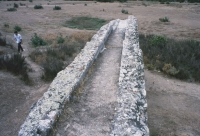Italica/Santiponce (Spain)
Roman aqueducts: Italica (country)
Santiponce - ITALICA
The first report of the aqueduct of Italica came from Rodrigo Cairo in 1624, but in 1960 A. García y Bellido was under the impression
that the aqueduct was lost. In 1974 cleaning work on the sewer system of the present Italica led to the discovery of remains of the aqueduct.
This was the beginning of the research which started at its sources in the valley of Tejada (near the present Escacena del Campo;
province of Huelva), 36,5 km from the castellum aquae in Italica.
The aqueduct was built according the rules as described by ancient writers like Vitruvius and Frontinus and in accordance with the
research undertaken by Montauzan, Ashby, Van Deman and Grenier.
The sources called "Fuente Grande" and "Fuente Pequeña" (the big and the small sources, 1 km N of Tejada) in the water conducting valley
of Tejada were the start of the aqueduct. Researchers did find the remains of three water catchment sites. On a hill nearby not less than
100 pieces of ashlar limestone were discovered some of which were cut or had been used as pilasters, and could be dated in Republican times
or in the beginning of the 1rst c AD. These remains could be related to a building, possibly a temple of Diana who can be interpreted
as a successor of the deity Tanit of the Ituci who once had a settlement here. Recently an inscription was found in the village of
Manzanilla (CIL II suppl. 5387) which hinted to Diana Augusta.
Depending on the terrain the aqueduct channel was supported by arches and substructions or built subterranean. The big challenge of the
 |
|
In the upper course of the river Guadiamar a few sources of the oldest aqueduct were uncovered which channel was built parallel to the river
and afterwards branched off to the East, direction Italica, mainly subterranean in a barrel-vault of concrete with circular manholes. This part,
fed by the water of the river Guadiamar can be dated in the 1c AD and brought water to Italica vetus.
More water was required for the town founded by Hadrian, Italica novus, which made an extension of the aqueduct necessary.
|
roman engineers was to cross the river basin of the Guadiamar (MAENOBA) into the valley of the Guadalquiver (BAETIS). The river Agrio
- a tributary of the Rio Guadiamar - was crossed on up to 14m high pillars.
Only 5 of the 71 pillars of the aqueduct bridge crossing the Frailes River (6 km SW of Gerena) are still visible (see drawing and photos).
It took some pains to discover 25 manholes (spiramina - mostly in bad condition) which played an important role during construction and
maintenance work and the aeration of the aqueduct. This part - from Tejada to the river Guadiamar - was built with
concrete (opus caementicum) covered with bricks, the manholes were square and the conduit had single or triple curb rolls.
From the river Guadiamar to Italica, the conduit was built of plain concrete, circular manholes were applied and the curbs
of the specus were square. The explanation can be that the first part was built in a later stage and that in essence two aqueducts were present.
In the upper course of the river Guadiamar a few sources of the oldest aqueduct were uncovered which channel was built parallel to the river
and afterwards branched off to the East, direction Italica, mainly subterranean in a barrel-vault of concrete with circular manholes.
This part, fed by the water of the river Guadiamar can be dated in the 1c AD and brought water to Italica vetus.
More water was required for the town founded by Hadrian, Italica novus, which made an extension of the aqueduct necessary.
Close to the river Guadiamar the water conduits from both sources were combined into one channel (4 km SW of Genera)
till they were split just before arriving at Italica (see map). At the highest point of the town the remains of a circular shaped castellum aquae
were discovered (but buried again) from where the water was distributed to the amphitheater, the fountains and the new baths in Italica novus.
Still quite a few lead pipes can be seen in the present Italica (see photo).
Moreover a paved road along the aqueduct was found (the Via XXII) which was used by the construction and maintenance of the work.
Technical details proves that the oldest part was built in the 1c AD and that the start of the construction work of the extension
took place in the 2nd c AD but only since the reign of the Antonines the work was finished.
The masonry of the bricks was of high quality. The use of triangle shaped bricks is one of the few examples of this material in Spain.
Bricks of different sizes were applied in the construction of the aqueduct which points to the fact that at the same moment
different work forces were active.
The aqueduct of Italica was exurbant and technical complex, possibly built with the support of the liberatores of Legio VII Genuna.
Probably the aqueduct felt in disuse during the middle of the 4c AD.
(English summary of the Spanish article canto1979)
W.D. Schram
Santiponce - ITALICA
| Item
| Info
|
| Length |
36,5 km |
| Cross-section |
0,55 x 0,70 |
| Volume |
m3/day |
| Fall |
0,11 % |
| Period |
1c AD; extension 2c AD |
| Features |
- 25 manholes
- castellum aquae
-
|
| Recommended literature :
| A.M. Canto (1979): El Acueducto Romano de Italica (in Spanish with German summary).
|
| Recommended website (in Spanish) :
| The same article, now on the web: Aquae Italicenses.
|
| How to visit :
| See above.
|
